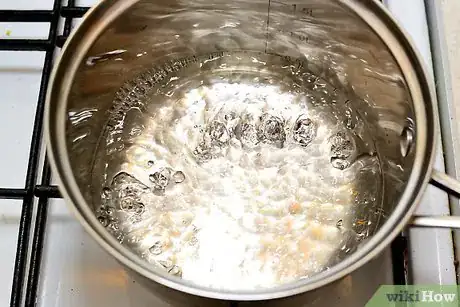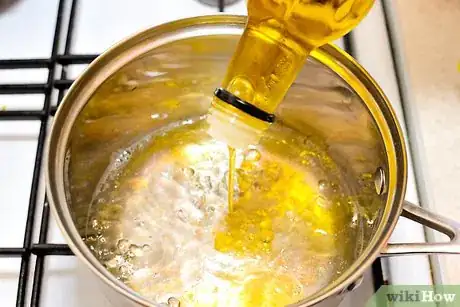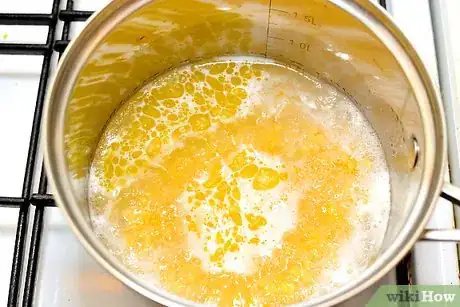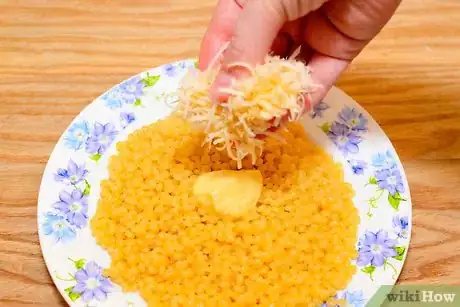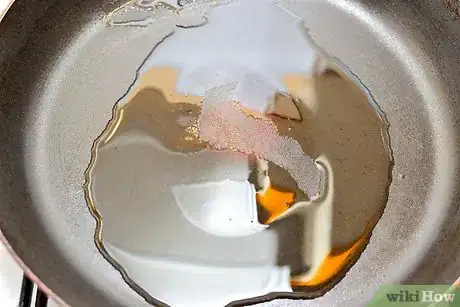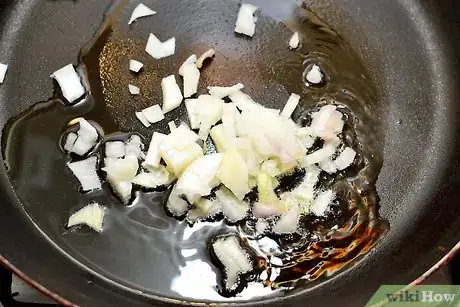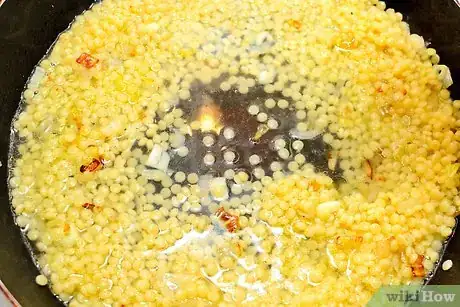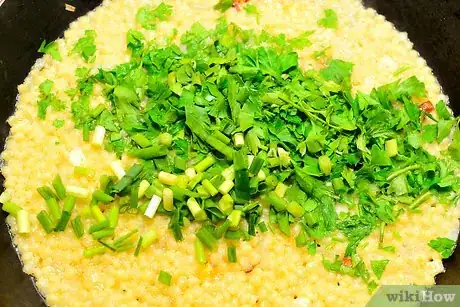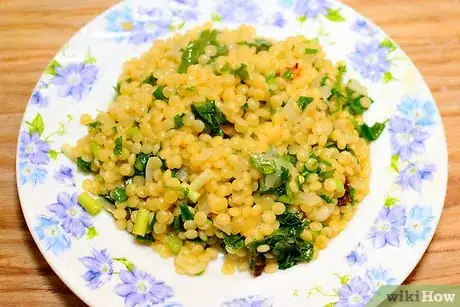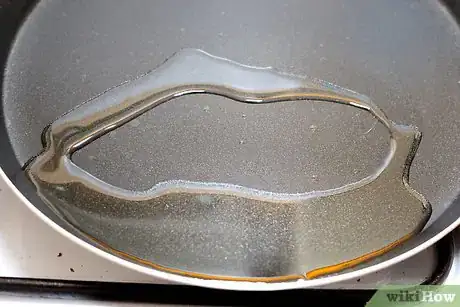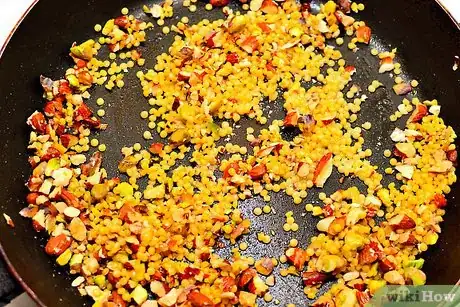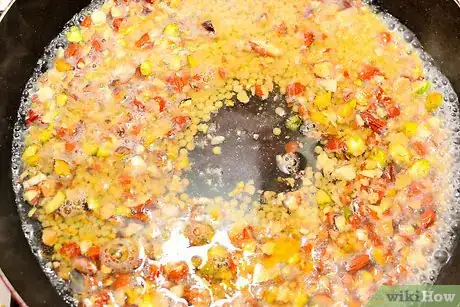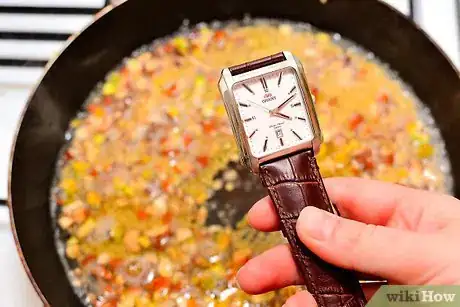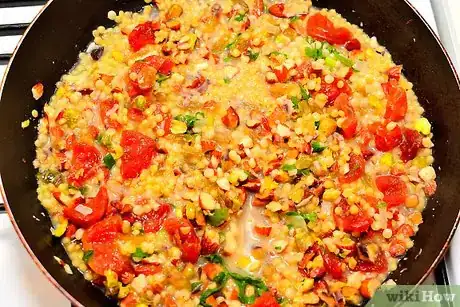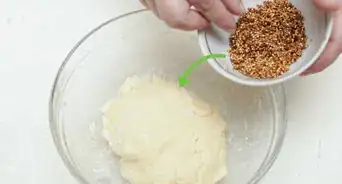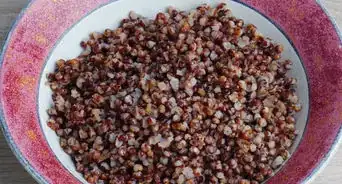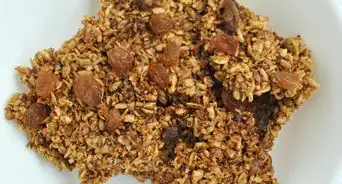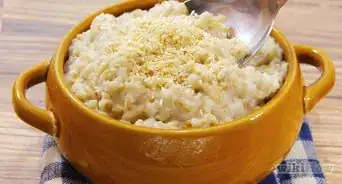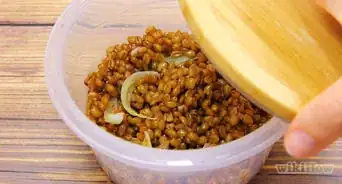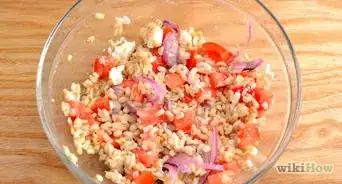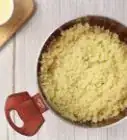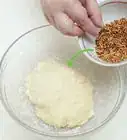This article was co-authored by Linda McNally. Linda Ingaldson McNally is a Personal Chef & Nutritionist and the Co-Founder of Sage Home Chef based in Portland, Oregon. Linda and her team specialize in personalized meal preparation and create seasonal menus to accommodate various dietary restrictions. She has extensive knowledge in nutrition relating to women's health, mindful eating, and therapeutic diets. Sage Home Chef won the AI Business Excellence Awards for Oregon's Best Healthy Cuisine Personal Chef Services and Best of Portland Personal Chef Services in 2022. Linda has a degree in Journalism, Social Justice, and Family Studies from the University of St. Thomas and earned an MS in Nutrition from the National University of Natural Medicine in Portland.
This article has been viewed 264,619 times.
Israeli couscous is larger than traditional couscous, and it is usually cooked like pasta by being boiled or toasted. It is a versatile ingredient, though, and it works well in both savory and sweet dishes. Keep reading to learn more.
Ingredients
Makes 2 to 4 servings
- 1 cup (250 ml) Israeli couscous
- 6 cups (1.5 L) water
- 2 Tbsp (30 ml) salt
- 1 Tbsp (15 ml) olive oil
- 2 Tbsp (30 ml) butter (optional)
- 1/4 cup (60 ml) grated Parmesan cheese (optional)
Makes 2 to 4 servings
- 1 1/3 cups (330 ml) Israeli couscous
- 1 3/4 cups (460 ml) water, broth, or stock
- 1 Tbsp (15 ml) olive oil
- 1 Tbsp (15 ml) butter
- 2 cloves garlic, minced
- 1/4 cup (60 ml) onion, minced
- 2 Tbsp (30 ml) fresh parsley, chopped
- 1 Tbsp (15 ml) fresh chives, chopped
- 1 Tbsp (15 ml) fresh oregano, chopped
- 1 tsp (5 ml) salt
- 1/2 tsp (2.5 ml) ground black pepper
Makes 2 to 4 servings
- 2 Tbsp (30 ml) olive oil
- 1 cup (250 ml) Israeli couscous
- 1 1/2 cups (375 ml) water
- 1 tsp (5 ml) salt
- 1/2 tsp (2.5 ml) ground black pepper
- 1/4 cup (60 ml) dried apricots, chopped
- 1/4 cup (60 ml) golden raisins, chopped
- 1/4 cup (60 ml) almonds or pistachios, chopped
- 1/4 cup (60 ml) fresh parsley, chopped
- 1/4 cup (60 ml) fresh mint, chopped
- 1 tsp (5 ml) ground cinnamon (optional)
- 2 Tbsp (30 ml) lemon juice (optional)
Steps
Boiled Israeli Couscous
-
1Bring a saucepan of water to boil. Fill a small saucepan with roughly 6 cups (1.5 L) of water and bring it to a boil over high heat.
- Note that the saucepan should be about 2/3 full. Add more or less water as needed to get this amount.
- As with most boxed pasta, this is more water than the couscous will actually absorb. Using this much ensures even boiling, though.
-
2Add salt and olive oil. Sprinkle the salt into the water and drizzle in the oil. Let it the water simmer for another minute or so afterward.
- You can add the oil and salt before you boil the water, but adding it after the water has already reached a boil will speed the process up because standard water boils faster than saltwater.
- Don't be afraid to add lots of salt. Only a small amount of the salt will actually be absorbed by the couscous. You need to add the salt to the couscous now, though, so that it can seep into the couscous as it cooks and flavors it from the inside out.
- The oil helps prevent the couscous from sticking together.
Advertisement -
3Add the Israeli couscous and simmer. After adding the couscous, reduce the heat to medium-low and cover the saucepan. Let it simmer for about 8 minutes.[1]
- The couscous should be “al dente.” In other words, it should be mostly tender, with just a little firmness when you bite into it.
- Note that the overall cooking time can vary by brand. Follow the package instructions to determine the proper amount of time.
-
4Drain well. Pour the contents of the saucepan through a fine-mesh colander. Gently shake the colander back and forth to shake the excess water off the cooked couscous.
- Alternatively, you could also drain the Israeli couscous using nothing more than the saucepan and the lid. Position the lid so that it is only slightly askew on top of the saucepan. There should be a gap smaller than the average pearl of couscous in between the pan and the lid. Pour the water out into the sink through this gap. Wear oven mitts to protect yourself from the steam.
-
5Season with butter and Parmesan cheese. If you want to liven the dish up, add a few dollops of butter and a generous helping of Parmesan cheese. Note, however, that couscous can be served without either.
- You can add sauteed vegetables to cooked couscous to add flavor.
- Saute garlic, onion, bell pepper, parsley, and green olives (pitted) over medium-high heat in a nonstick pan.
- Add cooked couscous to it after 3 – 5 minutes. You can also add a ladleful of the broth in which you have boiled couscous. Season with fresh parsley and serve.
Toasted Israeli Couscous
-
1Heat the oil in a large skillet with tall sides. Heat the oil over medium heat for a couple of minutes, just until it turns glossier and smoother.
- For best results, use a 2 quart (2 L) skillet. You could also use a saucepan instead of a skillet, if it proves more convenient.
-
2Cook the onion for 2 minutes. Add the chopped onion to the skillet and cook, stirring frequently, until tender.
- The onion should also show signs of caramelizing, but do not let it blacken or begin to burn. The fragrance of the onion should also become more potent.
-
3Cook the garlic for 1 minute. Add the minced garlic to the skillet and cook, stirring frequently, until fragrant.
- The garlic cooks a little more quickly than the onion, so you should add it after the onion has already cooked for a little while, first.
-
4Add the butter and couscous. Cook the contents of the skillet for 4 minutes, or until lightly browned.
- Stir the couscous continuously to prevent it from burning.[2]
- Toasting the couscous beforehand enhances the flavor, and it also allows the couscous to cook more evenly.
-
5Add the water and salt. Stir gently to distribute the salt and cover.
- The salt must be added now. By adding the salt alongside the water, you make it possible for the couscous to absorb the salt as it absorbs the water, thereby flavoring each pearl inside and out.
- If you want to make the couscous more flavorful, use broth or stock instead. Chicken stock and vegetable broth are both good options.
-
6Simmer for 8 to 10 minutes. When done, the liquid should be completely absorbed.
- Stir the couscous gently, pulling it up from the center to the sides of the pan. If liquid seeps down into the center of the pan, you need to cook the couscous a little longer to absorb the remaining liquid.
- Note that the overall cooking time can vary by brand. Follow the package instructions to determine the proper amount of time.
-
7Stir in the herbs and black pepper. Toss the pepper, parsley, chives, and oregano into the cooked couscous and stir well to distribute throughout.
- You can mix up the herbs to your liking. For instance, you can add rosemary, thyme, or cilantro. You could also add the zest of a lemon.
-
8Serve while still hot. Transfer individual serving portions onto serving dishes. Add extra salt and pepper to your own portion, if desired.
- If you want to give the couscous a little added zing, sprinkle it with a drizzle or two of lemon juice before serving.
Sweet Israeli Couscous
-
1Heat the oil in a saucepan. Pour the oil into a large saucepan and heat it on the stove over medium heat.
- For an even more flavorful twist, use lemon-flavored olive oil.
-
2Cook the couscous and nuts for 7 minutes.[3] Add the couscous and chopped nuts to the oil in the pan. Stir continually until the couscous and nuts toast to a light golden brown.
- Stir the couscous and nuts continuously to prevent them from burning.
- Toasting the couscous and nuts will enhance their flavor. Most nuts will work well, but almonds or pistachios are among the best to consider. For a change, though, you could try pine nuts, macadamia nuts, or mixed nuts.
-
3Add the water, salt, and pepper. Bring the contents of the pan to a boil.
- Stir well to distribute the salt and pepper throughout the toasted couscous and nuts.
-
4Simmer for 10 minutes. Reduce the heat and cover, cooking until the couscous has absorbed all the liquid in the skillet.
- Stir the couscous gently, pulling it up from the center to the sides of the pan. If liquid seeps down into the center of the pan, you need to cook the couscous a little longer to absorb the remaining liquid.
- Note that the overall cooking time can vary by brand. Follow the package instructions to determine the proper amount of time.
-
5Mix in the dried fruit and herbs. Toss the dried apricots, golden raisins, parsley, and mint into the cooked couscous and stir to distribute throughout.
- You could also change up the dried fruits in this recipe. For instance, you could use standard raisins, dried tart cherries, dried cranberries, or dried figs.
-
6Serve with cinnamon and/or lemon juice, if desired. Transfer the couscous to serving dishes and sprinkle each serving with a little cinnamon or a drizzle of lemon juice. Alternatively, you could serve the couscous without any garnish.
Things You'll Need
- Saucepan or skillet
- Wooden spoon
- Colander (optional)
- Serving dishes
References
About This Article
To cook Israeli couscous, start by bringing a small saucepan of water to boil. Next, add salt and olive oil and allow the water to simmer for another minute before adding the couscous. After you mix in the couscous, reduce the heat and cover the saucepan, simmering the mixture for 8 minutes. When the couscous is “al dente,” drain it through a fine mesh colander. Finally, season the couscous with butter and Parmesan cheese before serving. To learn how to make toasted Israeli couscous, keep reading!
